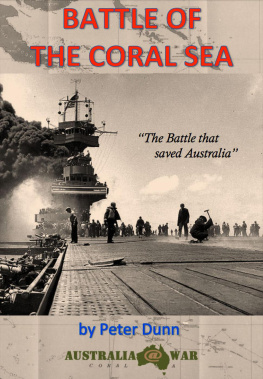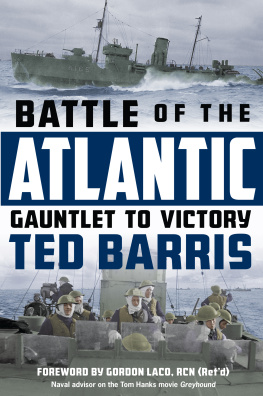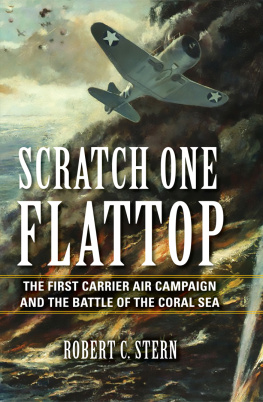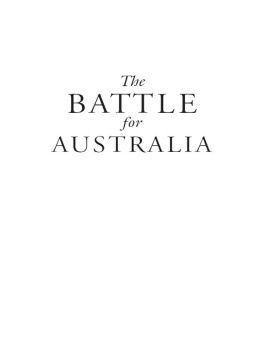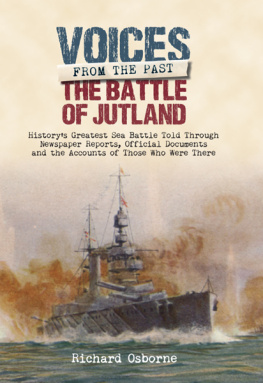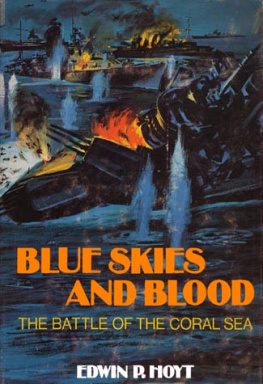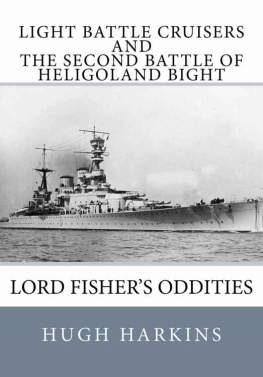Acknowledgements
I'd like to thank Ken Gray, David Stubblebine, Anne Mealing, Daniel Leahy, Douglas Campbell and Karen Nunan for their assistance with this book.
While every precaution has been taken in the preparation of this book, the publisher assumes no responsibility for errors or omissions, or for damages resulting from the use of the information contained herein.
BATTLE OF THE CORAL SEA
First edition. May 24, 2017.
Copyright 2017 Peter Dunn.
ISBN: 978-1386402329
Written by Peter Dunn.
10 9 8 7 6 5 4 3 2 1
T he Battle of the Coral Sea was the first major naval engagement in history, which was decided without the opposing ships firing a shot at each other. The battle was brought to the opposing ships by the naval air support of the opposing enemy force. It was a tactical victory for the Japanese but a strategic victory for the Allies. The Prime Minister of Australia, John Curtin was so concerned at the time of the Battle of the Coral Sea that he warned Australians "invasion is a menace capable of becoming an actuality at any hour."
Air attacks on the enemy at Lae and Salamaua on 10 March 1942 did not halt the Japanese move southward. By mid April 1942, the Japanese were moving their forces through the Mandates in readiness for a renewal of their offensive. Their strongholds in New Guinea, New Britain and the Solomon Islands gave them an opportunity to threaten all of Melanesia and Australia if they wished.
The Japanese had bases at the following locations:
Rabaul, New Britain
Gasmata, New Britain
Kavieng, New Ireland
Salamaua, New Guinea
Lae, New Guinea
Watom Island
Ulu Island
Dyaul Island
Kieta, Bougainville Island
Buin, Bougainville Island
Buka Island, Solomons
Faisi Island, Solomons
Japanese air reinforcements were believed to be enroute through the Marianas and the Marshall Island groups.
Simpson Harbour at Rabaul, was the main Japanese port for convoys, with lesser activity at Kavieng, Watom, Ulu, Dyaul, Lae and Salamaua.
A few Japanese combatant units, operated almost exclusively in the Rabaul area. Typically an occasional aircraft carrier transporting aircraft, a submarine tender, 3 or more submarines, a seaplane tender and several light cruiser, destroyers and gunboats would be present at Rabaul.
An estimated 3 Japanese aircraft carriers, 2 or 3 battleships, 3 heavy cruisers, 2 light cruisers, 16 destroyers, a submarine tender, 6 submarines, 2 converted seaplane tenders, 2 mine layers, 8 gunboats, 9 transports or cargo ships and 8 merchantmen were positioned at Palau and Truk in the Mandates in preparation for a possible move southwards.
During April 1942, there was evidence that the Japanese were planning to invade Port Moresby. The Allies believed that the Japanese would start major operations in the Rabaul area on about 28 April 1942 as part of a seaborne invasion of Port Moresby, or the Lower Solomons or both.
The Japanese operational plans called for six large aircraft carriers of the Japanese combined fleet to sail from Truk and head south of the Solomons and then west into the Coral Sea. Their role was to support and protect the invasion fleet headed for Port Moresby. This was all part of Japan's "Operation MO" which had three objectives:
- With the co-operation of the South Seas Army detachment and the Navy, Japanese forces would occupy Port Moresby and important positions on Tulagi and in south eastern New Guinea
- They would establish air bases and strengthen their air operations in the Australian area
- Successively an element would carry out a sudden attack against Nauru and Ocean Island and secure the phosphorous resources located there.
The invasion fleet was to consist of 5,000 marines of the Japanese Special Naval Landing Forces in 12 transports escorted by destroyers and cruisers with one light aircraft carrier to provide air cover. They were scheduled to attack Port Moresby in the first week in May 1942. They were to assemble at Rabaul and sail down through the Louisiade Archipelago around the eastern end of New Guinea and attack Port Moresby.
The role of the six aircraft carriers was to attack any Allied Naval forces trying to intercept the Japanese Invasion Fleet. Following the invasion of Port Moresby, the six aircraft carriers were due to head southwards to mount a massive 300 aircraft air-raid on Townsville.
On 18 April 1942, Colonel Doolittle launched his daring bombing raid on Tokyo, Yokohama, Kobe and Kyoto using B-25 Mitchell bombers launched from the decks of US aircraft carriers. In fact General Tojo was flying back to Tokyo at the time of Doolitle's daring raid and his aircraft had to take evasive action to avoid an unfamiliar brown twin-engined aircraft, which the crew told a worried Tojo was a land-based American Mitchell bomber.
As a result of Doolittle's air raid, the Japanese changed their priorities in readiness for the invasion of Midway. The Japanese knew that the Americans only had four aircraft carriers in the Pacific Ocean. They knew that two of these carriers were used in Doolittle's raid on 18 April. Japanese intelligence knew that USS LEXINGTON CV-2 was in Pearl Harbor so that left only one aircraft carrier, the USS YORKTOWN CV-5 in the South Pacific.

NARA Photo # 19-N-17424.
USS Yorktown CV-5 on 21 July 1937

NARA Photo # 80-G-416362
USS Lexington CV-2 in October 1941
B ased on this, the Japanese decided to downgrade the Combined Fleet support for the Port Moresby Invasion to just a Task Force support and at the same time the 300 aircraft air-raid on Townsville was removed from their plans. (Wheh!!!) The Japanese despatched only two aircraft carriers, Zuikaku and Shokaku, and the light carrier Shoho to support the invasion of Port Moresby. The rest of the Japanese fleet would make preparations for the invasion of Midway.
The Japanese air strength at Rabaul was reaching a peak. Because the Allied codebreakers were able to read most of the Japanese Naval radio traffic, Admiral Chester Nimitz, Commander in Chief, Pacific Fleet CinCPac, was well aware of the Japanese plans.
Task Force 17 under Rear Admiral Frank J. Fletcher was still located in the Coral Sea area and Task Force 11 had returned to Pearl Harbor. Task Force 11, then under Rear Admiral Aubrey W. Fitch, left Pearl Harbor on 16 April 1942 and whilst on its way to Christmas Island it was ordered to divert course to the Coral Sea area to join up with Task Force 17 to oppose the expected Japanese threat.
Next page
